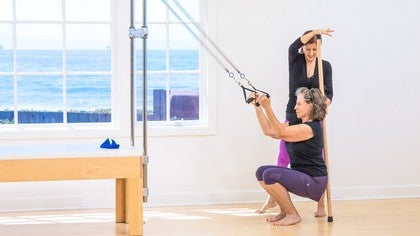Knee Pain
Sherri Betz
Tutorial 2373
Watch this Tutorial
Hi Emily,
So funny! I have said that, "The Knee is just the dumb joint in between the Hip and the foot and does whatever the hip and foot tell it to do!" Also: "the hip flexors and upper trapezius have a type A personality disorder!" Miss seeing you!
So funny! I have said that, "The Knee is just the dumb joint in between the Hip and the foot and does whatever the hip and foot tell it to do!" Also: "the hip flexors and upper trapezius have a type A personality disorder!" Miss seeing you!
7 years ago
Sherri, this was very, very helpful. Thank you for your clarity and the exercise progressions. I'll be using them with my clients.
7 years ago
Yes Nicole,
This would lead me to believe that the knee joint is structurally intact and the client most likely has a strength problem. Progressive resistance should then be added to the client's tolerance. Try to get the footbar in line with the hips/pelvis the way they would be in standing on the ground. Then, gradually increase the spring tension to the maximum that the Reformer can deliver (all springs on the second gear) progressing to single leg also with all springs on the second gear to build strength without pain. Remember, to build strength the client should fatigue within 8-12 repetitions. Once they have maxed out, then you would need to progress to the Wunda Chair or another vertical position with weights to add resistance.
This would lead me to believe that the knee joint is structurally intact and the client most likely has a strength problem. Progressive resistance should then be added to the client's tolerance. Try to get the footbar in line with the hips/pelvis the way they would be in standing on the ground. Then, gradually increase the spring tension to the maximum that the Reformer can deliver (all springs on the second gear) progressing to single leg also with all springs on the second gear to build strength without pain. Remember, to build strength the client should fatigue within 8-12 repetitions. Once they have maxed out, then you would need to progress to the Wunda Chair or another vertical position with weights to add resistance.
7 years ago
11-20 of 58
You need to be a subscriber to post a comment.
Please Log In or Create an Account to start your free trial.





































I would do 1 set on each side and then add a second set to the weaker side. To strengthen make sure that the client reaches fatigue within 8-12 repetitions. If they can perform 15-20 reps, the exercise is too easy or the resistance is too light.